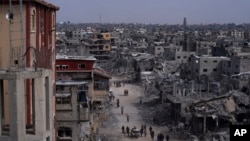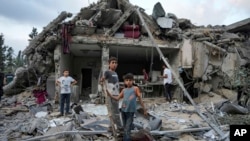The United Nations said Thursday that the war in the Gaza Strip has set back development there by 40 years, and that rebuilding will cost billions of dollars over many years.
“An early recovery program for three years to bring back hundreds of thousands of Palestinians to temporary shelters in their original locations with comprehensive community support, will cost between $2-3 billion,” said Abdallah Al Dardari, director of the Regional Bureau for Arab States at the U.N. Development Program (UNDP). “The overall reconstruction of Gaza today according to our estimate will be between $40-50 billion, at least.”
Dardari spoke to reporters from Amman, Jordan, where he launched an updated UNDP report on expected socioeconomic impacts of the war between Israel and Hamas, which hits the seven-month mark on Tuesday.
The conflict has taken a toll on Palestinian lives, with more than 34,000 killed and nearly 78,000 injured to date, according to the Hamas-run Gaza Health Ministry. By mid-April, UNDP says deaths and injuries amounted to at least 5% of Gaza’s population.
During the October 7 Hamas terror attacks inside Israel, at least 1,200 people were killed and 250 others kidnapped. More than 30 of those still in captivity are believed to be dead.
The fighting has leveled much of Gaza, damaging or destroying some 370,000 housing units and 9% of commercial properties. UNDP says even in its best-case scenario it would take 16 years — until 2040 — to reconstruct the destroyed homes, without repairing the damaged ones. If reconstruction timelines follow the same pattern as after the 2014 and 2021 wars between Hamas and Israel, the report says, Gaza would need approximately 80 years to restore the destroyed homes.
Regression to 1980 levels
Dardari said 40 years of development gains in Gaza have been lost, amounting to an investment of nearly $50 billion.
“That means that the levels of education and literacy will be affected dramatically at the end of this conflict,” he said. “But more dangerously, in our analysis, the impact of the conflict will stay with us for a long time, unless we quickly address temporary schooling, temporary health care, psycho-social support to the population, and bringing back basic services like water, sanitation, and electricity.”
While every Palestinian has been affected in some way by the conflict, the report found that the middle class has been most affected. If the war continues until July, it would bring a large part of the middle class below the poverty line, increasing the total number of Palestinians pushed into poverty to 3.32 million — or just over 60% of the population.
Palestinian GDP has also suffered dramatically since the war started, declining 25% — or nearly $7 billion. Dardari said that could reach 29% if the war continues into July.









